Yann Robin – Vulcano – Art of metal I & III

Continuer la lecture de Yann Robin – Vulcano – Art of metal I & III
Yann Robin – Vulcano – Art of metal I & III

Continuer la lecture de Yann Robin – Vulcano – Art of metal I & III
Les femmes chefs d’orchestre – Women on the podium
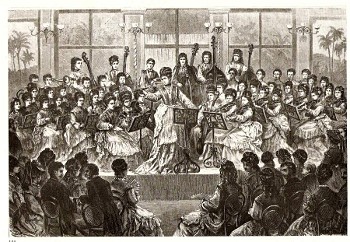
| Mélomanes misogynes de tout poil, il faudra vous y faire : on va finir par voir un nombre croissant de femmes chefs d’orchestre : il a déjà fallu que vous vous habituiez à en voir un nombre croissant au sein de l’orchestre (même aux cuivres !) – on se rappelle de la polémique lors du rejet par vote en 1983 de la clarinettiste Sabine Meyer par les Berliner philharmoniker après sa période probatoire : 73 contre, 4 pour… – Sans remonter à Fanny, la sœur de Félix Mendelssohn, on ne sait plus qu’il y eut de nombreux chefs d’orchestre féminins de la fin du 19e siècle à la 2e Guerre mondiale, en général à la tête d’orchestres entièrement féminins dans les années 20 / 30, à l’existence souvent bien éphémère.
À notre supposé mélomane misogyne, qu’en sera-t-il si, par extraordinaire, l’une d’entre elles vient à diriger en jupe ! Eh bien çà existe avec Silvia Sanz Torre dont je n’ai pas la date de naissance…
|
Misogynists music lover, you will have to keep with that: a growing number of women conductors: you have been unfortunate to see a growing number of women within the orchestra (even with coppers!) – one remembers the polemic at the time of the rejection by vote of the clarinetist Sabine Meyer in1983 by Berliner philharmoniker after her probationary period: 73 against, 4 for… -Without going back to Fanny, Felix Mendelssohn’s sister, one does not know any more that there were many female conductors from the end of the 19th century to the 2nd World war, in general at the head of entirely female orchestras in the 20/30′
Two young feminine conductors that we know a little: Susanna Mälkki, leader of the Ensemble Intercontemporain, who impressed us in two discs of contemporary music (Manoury & Mantovani). And Serâ Tokay, who has just given us an interview; she had just founded her chamber orchestra, « Philharmonie de Chambre Lutèce »; she impressed us in the two chamber symphonies by Schoenberg in Paris, some months ago. To our supposed misogynist music lover, what about, if by extraordinary, a woman conducts the orchestra dressed in a skirt… Well, Silvia Sanz Torre did it! |
||||||||||||||||||||||||||||||||||||||||||||||||||||||||||||||||||||||||||||||||||||||||||||||||||||||||||||||||||||||||||||||||||||||||||||||||||||||||||||||||||||||||||||||||||||||||||||||||||||||||||||||||||||||||||||||||||||||||||||||||||||||||||||||||||||||||||||||||
Some conductors are missing, since I could not get their birth date, even some wouldn’t give it to me… See also this list.
|
|||||||||||||||||||||||||||||||||||||||||||||||||||||||||||||||||||||||||||||||||||||||||||||||||||||||||||||||||||||||||||||||||||||||||||||||||||||||||||||||||||||||||||||||||||||||||||||||||||||||||||||||||||||||||||||||||||||||||||||||||||||||||||||||||||||||||||||||||
| From the New Yorker, an interesting interview : »A formidable figure in Russian music, Temirkanov served as a mentor both to Gergiev and later to Petrenko. The interviewer, the Paris-based pianist and composer Elena Gantchikova, deserves credit for grilling him. A Russian-speaking friend provided this translation:Q.: In your opinion, could a woman conduct? A.: In my view, no. Q.: Why not?! A.: I don’t know if it’s God’s will, or nature’s, that women give birth and men do not. That’s something that no one takes offense at. But if you say that a women can’t conduct, then everyone’s offended. As Marx said, in response to the question “What’s your favorite virtue in a woman?”—“Weakness.” And this is correct. The important thing is, a woman should be beautiful, likable, attractive. Musicians will look at her and be distracted from the music! Q.: Why? There are women in the orchestra; people indifferent to a women’s charms. Besides, how many times would you be enraptured by appearances? After all, it’s something you tire of, and switch to the heart of the question. Statistically, of course, there are women conductors. A.: Yes, they do exist. Q.: Nevertheless, you maintain that these are less than women, or less than conductors. A.: No, simply that in my opinion, it’s counter to nature. Q.: And what is it in the conductor’s profession that runs counter to a woman’s nature? That’s counter to the essence of the conductor’s profession? A.: The essence of the conductor’s profession is strength. The essence of a woman is weakness. » From Artsjournal.com, an other intersting point of view by : Jorma Panula has been the most successful spotter and trainer of conductors for the past 30 years. His pupils include Esa-Pekka Salonen and at least 20 others who hold international posts. Q: Do you think it is good that women enter the profession and become conductors? JP: No! What the hell, we have men already. It is such a limited profession… They can try, but it is a completely different deal. I can’t comment on media or public opinion. But women… Of course they are trying! Some of them are making faces, sweating and fussing, but it is not getting any better – only worse! They can come [to my masterclasses] and try. It’s not a problem – if they choose the right pieces. If they take more feminine music. Bruckner or Stravinsky will not do, but Debussy is OK. This is a purely biological question. Panula’s comments have provoked outrage in Finland. Salonen has tweeted (in Finnish): ‘Conducting is about skill, not biology. There is no reason why women cannot do it equally well or better.’ |
|||||||||||||||||||||||||||||||||||||||||||||||||||||||||||||||||||||||||||||||||||||||||||||||||||||||||||||||||||||||||||||||||||||||||||||||||||||||||||||||||||||||||||||||||||||||||||||||||||||||||||||||||||||||||||||||||||||||||||||||||||||||||||||||||||||||||||||||||
Ensemble intercomtemporain – Susanna Mälkki

|
Né en 1952, Philippe Manoury est un des plus importants compositeurs français vivants. Dans le cadre d’une série cherchant à faire découvrir la musique contemporaine aux mélomanes de bonne volonté, voici une excellente introduction à ce compositeur, avec ces « Fragments pour un portrait ». Une des multiples préoccupations de Manoury est la notion de « work in progress » (il cite volontiers Francis Bacon) chère à Pierre Boulez ; au sujet de cette œuvre, il déclare : « La totalité [des 7 mouvements] devrait tendre vers l’émergence d’un « portrait », d’une image musicale qui, je l’espère, devrait apparaître en filigrane sur l’ensemble de ces pièces. » cf. son commentaire de l’œuvre. On trouvera sur son site des extraits de chacun des 7 mouvements. Comme pour Gruppen de Stockhausen ou Le sette chiese de Mantovani, l’œuvre est pour plusieurs ensembles instrumentaux (3 ici). Chemins fait penser aux introductions du Sacre, on trouvera des « accelerando-diminuendo » à la Berg, etc., tout cela donnant une musique très vivante, rythmée, colorée. |
Born in 1952, Philippe Manoury is one of the foremost actual French composers. In our series seeking to let music lovers discover contemporary music, this is an excellent introduction to the composer, with these « Fragments for a portrait ». |
![Philippe Manoury - La ville [...première sonate...] Philippe Manoury - La ville [...première sonate...]](https://vagnethierry.fr/WordPress3/wp-content/uploads/2012/08/manoury2.jpg) |
|
|
« La ville […première sonate…] » date de 2002. Ce n’est pas une sonate même si l’oeuvre dure près de 36′, puisqu’elle comporte pas moins de 19 mouvements… Dans la plaquette du SACD (superbe prise de son), l’auteur évoque de façon presque onirique les correspondances entre sa récitation mentale de la Sonate de Liszt et les images perçues lors de sa déambulation dans le vieux quartier praguois de Malá Strana. Il évoque aussi des procédés de Berg, tels que certains morceaux rétrogrades inversés. C’est ce qui donnera la structure de l’oeuvre. Citons-le : « C’est sur le principe des « formes différées » que s’articule cette œuvre. Des éléments monodiques (lents et méditatifs), des résonances harmoniques, des échelles sonores descendantes, des « toccatas », des « fugues » s’entremêlent les uns aux autres dans une forme dirigée distribuée symétriquement par rapport à un centre. Cette symétrie effectue un retour en arrière, comme si l’œuvre devait revenir à son point de départ. Mais il s’agit d’une fausse symétrie (le parcours global n’est pas inversement identique) que vient perturber de vraies symétries, (il arrive que des bouts de parcours reproduisent un cheminement voisin du précédent). Le centre est polarisé sur une note pivot (ré) qui s’impose peu à peu depuis le début et s’incarne dans un grand silence avant que l’œuvre ne semble revenir à son point de départ. » Un certain ésotérisme semble poindre ici, mais en fait cette œuvre est très vivante. Elle gagne à être lue sur un ordinateur : on s’évade ainsi de la linéarité d’écoute pour comparer un à un les mouvements en miroir… déformé. |
recording), the author evokes in an almost dreamlike way the correspondences between his mental recitation of the Sonata of Liszt and the images perceived during his wandering in the old Prague area of Malá Strana. It evokes also Berg’s processes, such as certain reversed and retrograde pieces. This will give the structure of work. Let us quote him: “It is on the principle of the “differed forms” that this work is articulated. Monodic Elements (slow and meditative), harmonic resonances, downward sound scales, “toccatas”, “runnings away” intermingle the ones with the others in a directed form distributed symmetrically compared to a center. This symmetry carries out a return behind, as if work were to return to its starting point. But it is about a false symmetry (the total course is not conversely identical) which comes to disturb true symmetries […]. The center is polarized on a note pivot (D) which is essential little by little since the beginning and is incarnated in a great silence before work does not seem to return to its starting point. “ A certain esotericism seems to come up here, but this work carries a very lively listening. It gains being read on a computer: one escapes thus from the linearity of listening to compare the movements one by one on the two sides of the mirror … deformed.
|
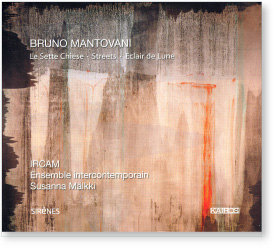
Ensemble intercomtemporain – Susanna Mälkki
|
Un compositeur majeur de notre temps de 38 ans, à la tête d’un catalogue imposant. Philippe Jordan a créé à Paris son Concerto pour violon en février dernier ; quand on connaît l’exigence de ce chef vis-à-vis des partitions contemporaines… Pour la description de ces 9 pièces, on se référera bien sûr aux propos de l’auteur (+extraits de l’œuvre). On n’indiquera ci-dessous que nos rapides impressions à l’écoute de l’œuvre, destinées simplement à inciter à la découverte. Au fait, ne pas confondre Bruno Mantovani et Annunzio Paolo Mantovani, chef d’orchestre de musique légère !
|
A major composer of our time – 38 yo – having already composed numerous works. A gratifying work with splendid sonorities: Le sette chiese (« seven churches ») was created in 2002 in Strasbourg under the direction of Jonathan Nott. For the description of these 9 pieces, refer of course to the words of the author (+ excerpts). We indicate below our quick impressions, simply willing to invite to the discovery. Just don’t confuse Bruno Mantovani and Annunzio Paolo Mantovani, a famous conductor of light music! |
|
I – La piazza Santo Stefano |
I – The Piazza Santo Stefano |
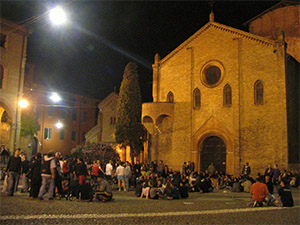 |
|
|
Des ostinatos, des fulgurances aux vents, des éclats de percussions donnent effectivement l’impression d’une vie grouillante devant l’église. |
Ostinatos, searing winds, percussion fragments actually give the impression of a bustling life in front of the Church. |
|
L’église de Saint Jean-Baptiste |
The church of San Giovanni-Battista |
|
La première partie est un long crescendo, très dynamique, suivi d’un épisode mystérieux, avec de nombreux micro-intervalles, de multiples interventions solistes, bois ou cordes, le tout dans une atmosphère très fourmillante. |
The first part is a long crescendo, very dynamic, followed by a mysterious episode, with many micro-intervals, multiple soloist interventions, wood or string, all in a very lively atmosphere. |
|
La crypte |
The crypt |
|
Cette partie reprend un peu l’esprit de la précédente, avec des babillages de la clarinette, puis du violon sur de nombreux traits secs, rapides et aigus. On pense à des envolées d’oiseaux ou des nuées d’insectes lumineux. Quelques références au grégorien à la fin donnent un tonalité religieuse à cette pièce. |
This part takes a little spirit of the previous, with babblings of the clarinet and violin, dry, fast and acute. One thinks of birds flights orf luminous insects. A few references to Gregorian chant at the end give a religious tone to this piece |
|
La basilique du sépulcre |
Tomb basilica |
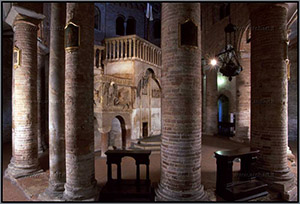 |
|
|
La pièce la plus longue (9’24 »). Une longue séquence aux pianos et percussions sourdes évoque l’obscurité de l’endroit, l’apparition du violon puis de flûtes suraigües amène la 2e partie sensée illustrée la lumière éclairant les reliques présentes dans un dynamisme croissant et virtuose jubilatoire. |
The longest piece (9’24 « ). A long sequence of pianos and low percussion refers to the darkness of the place, the appearance of the violin and super acute flute brings to part 2 illustrating the light illuminating the present relics in a growing dynamic and exhilarating virtuoso. |
|
L’église du martyrium |
Martyrdom Church |
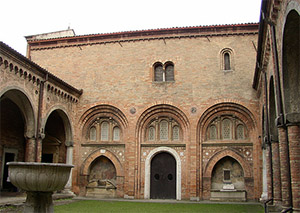 |
|
|
Une visite des 5 chapelles de l’église avec une fin militaire. |
A visit of the 5 chapels of the Church with a military end. |